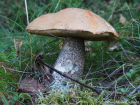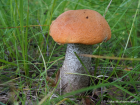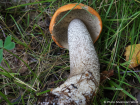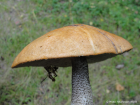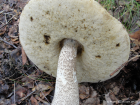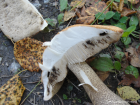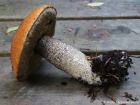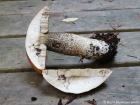Cap clear orange or red-brown. Round to start with, then oval and finally convex. Grainy or smooth as dry, and sticky when damp. The orange cap skin hangs down over the margin. Pores are circular and small. They are at first whitish, then buff, darkening rust where bruised. Tubes are similarly coloured as the pores, wine-coloured where cut, and depressed. Stem tapers slightly towards the apex and has a white, pale grey, or yellowish-grey surface covered with dark brown or blackish woolly scales. When cut, the pale flesh of the stem changes from pale grey near the apex to a blue-green colour and eventually darkens to an almost black shade, particularly near the base of the stem. The stem has no ring. Spore print ochraceous brown.
Microscopic Features: The spores are fusiform in shape, with thin walls measuring 11-16 x 3.5-4.5µm. They are inamyloid.
Leccinum versipelle on the www.first-nature.com web site.
Many mushrooms are poisonous, and some can be lethally toxic. Distinguishing between edible and poisonous mushrooms can be very challenging. Therefore, we strongly advise against consuming wild mushrooms. This website does not contain any information about the edibility or toxicity of mushrooms.
Although efforts have been made to ensure accuracy on this website, the information may contain errors and omissions. Therefore, all content provided is for educational and informational purposes only and should not be relied upon or used as a basis for consuming any plants or mushrooms.
External links are provided for reference only. We do not endorse or take responsibility for the content, advice, or products found on these sites or in any advertisements shown on this website.
